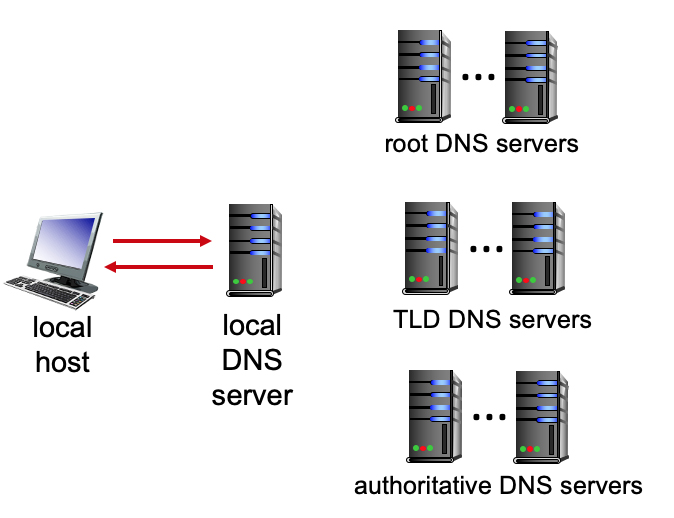DNS functions.
Match the function of a server to a given type of DNS server in the DNS server hierarchy.
Why does the DNS perform caching?
What is the value of caching in the local DNS name server? Check all that apply.
What's in the DNS type A resource record?
What information does the type “A” resource record hold in the DNS database? Check all that apply.
DNS in Action (1).
Suppose that the local DNS server caches all information coming in from all root, TLD, and authoritative DNS servers for 20 time units. (Thus, for example, when a root server returns the name and address of a TLD server for .com, the cache remembers that this is the TLD server to use to resolve a .com name). Assume also that the local cache is initially empty, that iterative DNS queries are always used, that DNS requests are just for name-to-IP-address translation, that 1 time unit is needed for each server-to-server or host-to-server (one way) request or response, and that there is only one authoritative name server (each) for any .edu or .com domain.

Consider the following DNS requests, made by the local host at the given times:
- t=0, the local host requests that the name gaia.cs.umass.edu be resolved to an IP address.
- t=1, the local host requests that the name icann.org be resolved to an IP address.
- t=5, the local host requests that the name cs.umd.edu be resolved to an IP address. (Hint: be careful!)
- t=10, the local host again requests that the name gaia.cs.umass.edu be resolved to an IP address.
- t=12, the local host requests that the name cs.mit.edu be resolved to an IP address.
- t=30, the local host again requests that the name gaia.cs.umass.edu be resolved to an IP address. (Hint: be careful!)
Which of the requests require 8 time units to be resolved?
DNS in Action (2).
[This question is the same as an earlier question, except for the question statement at the very end.] Suppose that the local DNS server caches all information coming in from all root, TLD, and authoritative DNS servers for 20 time units. (Thus, for example, when a root server returns the name and address of a TLD server for .com, the cache remembers that this is the TLD server to use to resolve a .com name). Assume also that the local cache is initially empty, that iterative DNS queries are always used, that DNS requests are just for name-to-IP-address translation, that 1 time unit is needed for each server-to-server or host-to-server (one way) request or response, and that there is only one authoritative name server (each) for any .edu or .com domain.

Consider the following DNS requests, made by the local host at the given times:
- t=0, the local host requests that the name gaia.cs.umass.edu be resolved to an IP address.
- t=1, the local host requests that the name icann.org be resolved to an IP address.
- t=5, the local host requests that the name cs.umd.edu be resolved to an IP address. (Hint: be careful!)
- t=10, the local host again requests that the name gaia.cs.umass.edu be resolved to an IP address.
- t=12, the local host requests that the name cs.mit.edu be resolved to an IP address.
- t=30, the local host again requests that the name gaia.cs.umass.edu be resolved to an IP address. (Hint: be careful!)
Which of the requests require 6 time units to be resolved?
DNS in Action (3).
[This question is the same as an earlier question, except for the question statement at the very end.] Suppose that the local DNS server caches all information coming in from all root, TLD, and authoritative DNS servers for 20 time units. (Thus, for example, when a root server returns the name and address of a TLD server for .com, the cache remembers that this is the TLD server to use to resolve a .com name). Assume also that the local cache is initially empty, that iterative DNS queries are always used, that DNS requests are just for name-to-IP-address translation, that 1 time unit is needed for each server-to-server or host-to-server (one way) request or response, and that there is only one authoritative name server (each) for any .edu or .com domain.

Consider the following DNS requests, made by the local host at the given times:
- t=0, the local host requests that the name gaia.cs.umass.edu be resolved to an IP address.
- t=1, the local host requests that the name icann.org be resolved to an IP address.
- t=5, the local host requests that the name cs.umd.edu be resolved to an IP address. (Hint: be careful!)
- t=10, the local host again requests that the name gaia.cs.umass.edu be resolved to an IP address.
- t=12, the local host requests that the name cs.mit.edu be resolved to an IP address.
- t=30, the local host again requests that the name gaia.cs.umass.edu be resolved to an IP address. (Hint: be careful!)
Which of the requests require 2 time units to be resolved?
The local DNS server.
Check all of the phrases below that state a true property of a local DNS server.
The DNS authoritative name server.
What is the role of an authoritative name server in the DNS? (Check all that apply)
DNS and HTTP Caching.
We learned that in HTTP web browser caching, HTTP local web server caching, and in local DNS caching, that a user benefits (e.g., shorter delays over the case of no caching) from finding a local/nearby copy of a requested item. In which of the following forms of caching does a user benefit from its not only from its own recent requests (and cached replies) but also from recent requests made from other users?